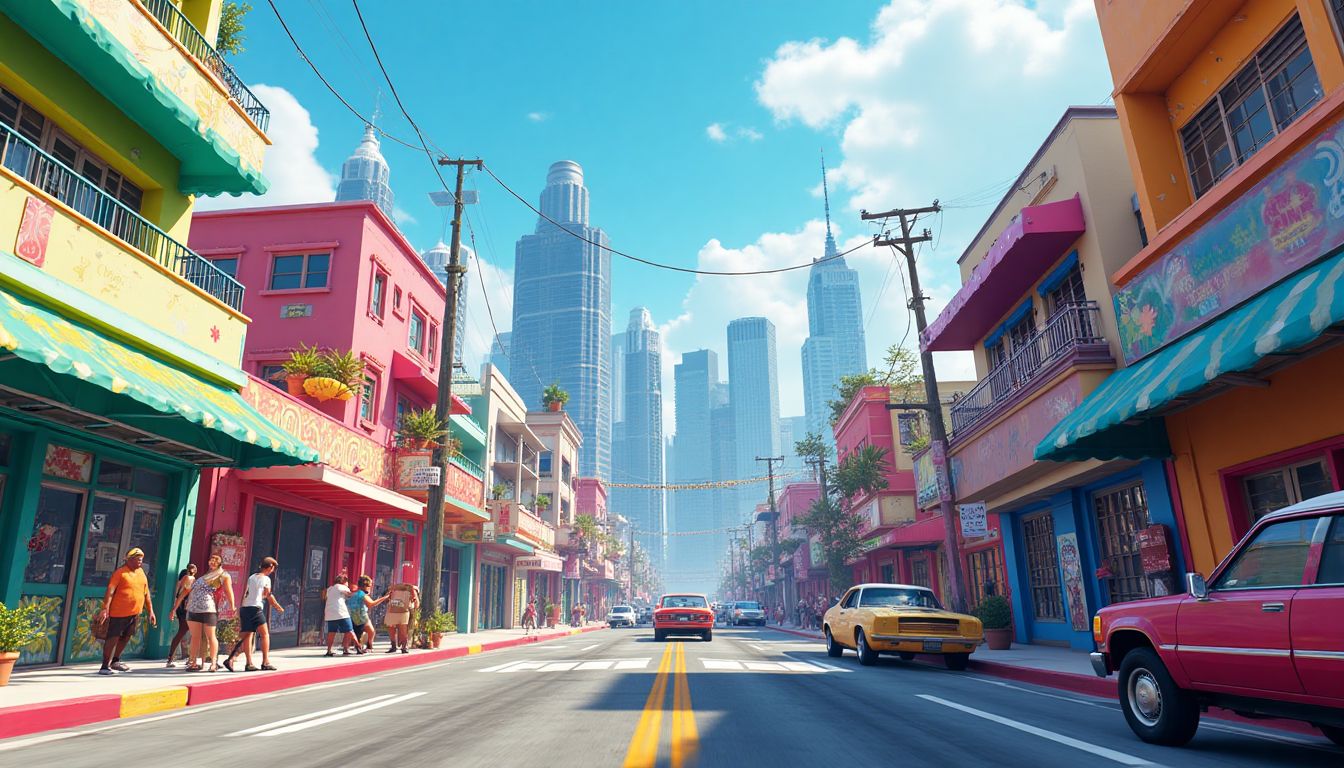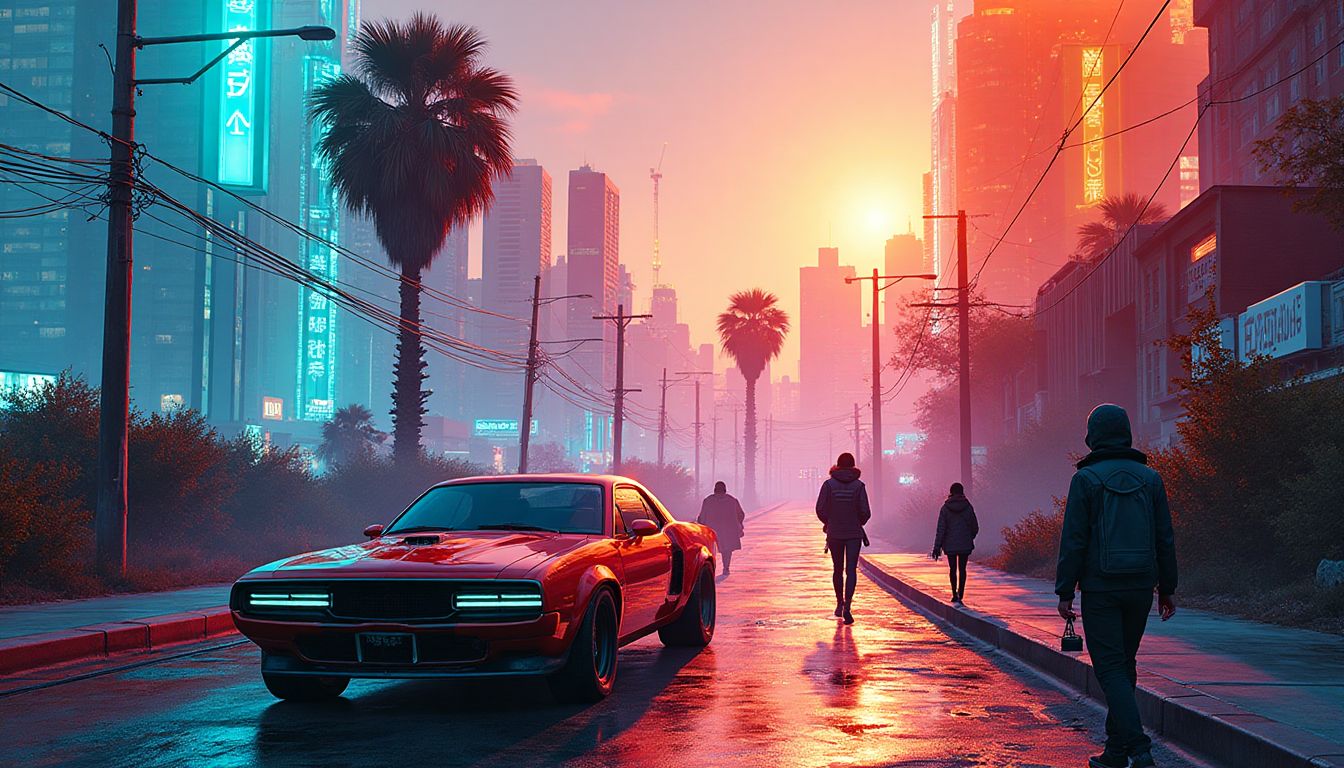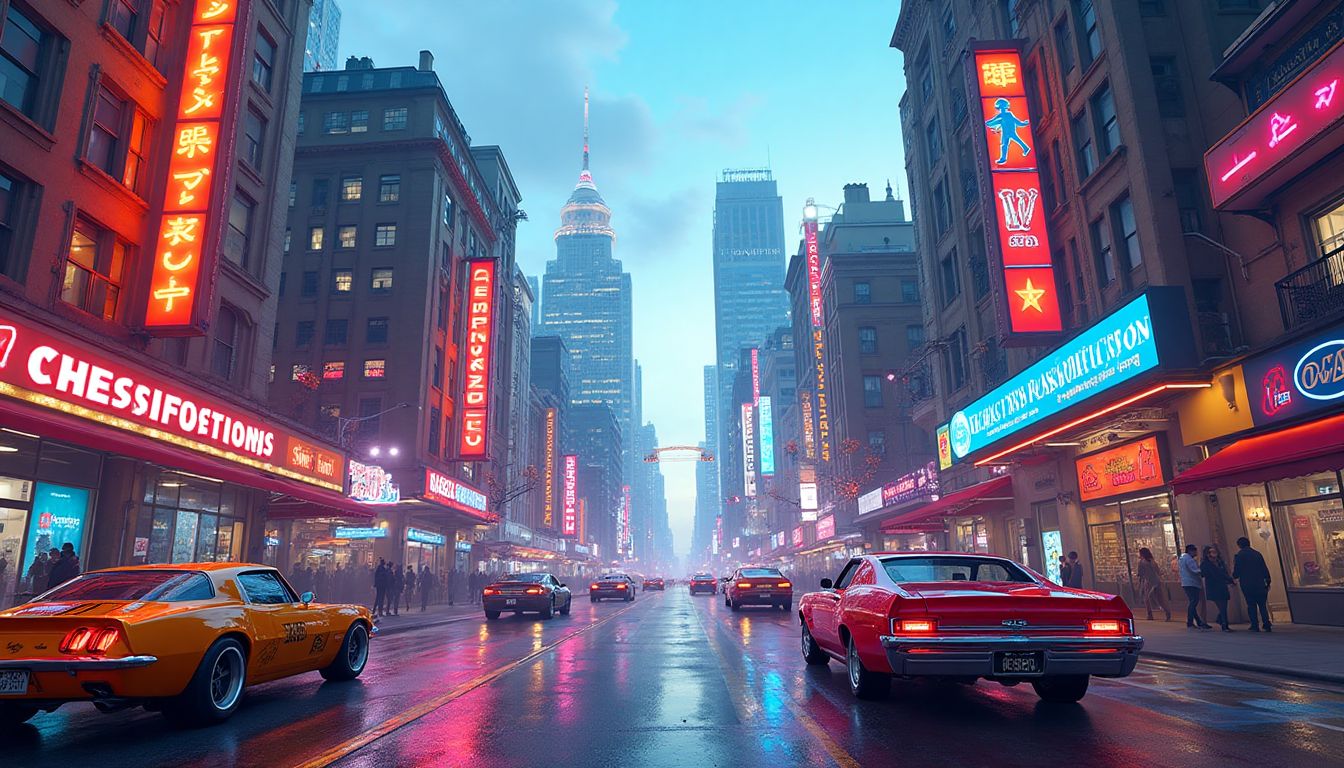What if I told you that the Grand Theft Auto (GTA) series is not just a game but a cultural and technological behemoth that has reshaped the entertainment industry? Since its debut in 1997, GTA has grown from a pixelated top-down shooter to a sprawling, hyper-realistic open-world experience that has sold over 400 million copies worldwide. But how big is GTA, really? Is it the size of its virtual cities, the billions it has earned, or the countless hours players have spent exploring its digital streets? The answer is all of the above—and more.
Renowned game designer Hideo Kojima once said, "GTA is not just a game; it’s a mirror of society." Similarly, Jane McGonigal, a leading researcher in game design, has praised GTA for its ability to create immersive worlds that blur the line between reality and fiction. Even Elon Musk, the tech mogul, has admitted to spending hours in GTA’s virtual playground. This article will explore the many dimensions of GTA’s "bigness," from its physical game worlds to its cultural and financial impact, and how artificial intelligence (AI) could shape its future.
The Physical Size of GTA’s Game Worlds
When it comes to the physical size of GTA’s game worlds, the series has come a long way. The original GTA, released in 1997, featured a top-down view of three fictional cities: Liberty City, Vice City, and San Andreas. These cities were small by today’s standards, but they laid the foundation for what would become one of the most expansive open-world franchises in gaming history.
Evolution of GTA’s Open Worlds
With each new installment, GTA’s game worlds have grown larger and more detailed. Rockstar Games, the developer behind the series, has consistently pushed the boundaries of open-world design. GTA III, released in 2001, introduced a fully 3D Liberty City, while GTA: Vice City (2002) transported players to a neon-soaked Miami-inspired metropolis. GTA: San Andreas (2004) took things even further, offering a massive map that included three major cities and vast rural areas.
The Scale of GTA V’s Los Santos
GTA V, released in 2013, set a new standard for open-world games. Its map, which includes the city of Los Santos and the surrounding countryside, spans approximately 49 square miles. To put that into perspective, it’s larger than the real-life city of Manhattan. The level of detail is staggering, from the bustling streets of downtown Los Santos to the serene beaches of Vespucci. Rockstar achieved this by combining procedural generation with hand-crafted design, creating a world that feels both vast and alive.
Comparing GTA to Other Open-World Games
How does GTA’s world size compare to other open-world games? While GTA V’s map is impressive, it’s not the largest. Games like The Witcher 3 and Red Dead Redemption 2 offer even larger maps, but GTA’s strength lies in its density and interactivity. Every corner of Los Santos is filled with activities, secrets, and stories, making it feel more alive than many of its competitors.
The Financial Success of GTA
When it comes to making money, the Grand Theft Auto (GTA) series is like a high-speed heist that never ends. With over Rockstar Games reporting 400 million copies sold across the franchise, GTA isn’t just a game—it’s a financial empire. To put that into perspective, if every copy of GTA were a dollar bill, you could stack them to the moon and back. Twice. And that’s not even counting the billions generated by GTA Online, the multiplayer component that’s become a cash cow for the company.
Sales Figures and Revenue
GTA V, the crown jewel of the series, has raked in over $6 billion since its release in 2013. That’s more than the box office earnings of Marvel’s Avengers and Star Wars combined. It’s not just a game; it’s a cultural and financial juggernaut. The series as a whole has surpassed $7 billion in revenue, making it one of the most profitable entertainment franchises of all time. To put it bluntly, GTA prints money faster than a counterfeit operation in Los Santos.
GTA Online: A Billion-Dollar Business
If GTA V is the king, then GTA Online is the kingdom. Launched in 2013, this multiplayer mode has become a billion-dollar business, thanks to its clever use of microtransactions. Players can buy in-game currency, known as “Shark Cards,” to purchase everything from luxury cars to private jets. It’s like a virtual economy on steroids. In 2020 alone, GTA Online generated over $1 billion in revenue. That’s more than some countries’ GDPs. Who knew stealing virtual cars could be so lucrative?
The Economic Impact of GTA
Beyond its direct revenue, GTA has had a ripple effect on the gaming industry. It’s inspired countless open-world games, from Watch Dogs to Cyberpunk 2077. It’s also created jobs, from developers at Rockstar to streamers on Twitch and YouTube who make a living playing the game. GTA isn’t just a game; it’s an economic engine that keeps on giving.
The Cultural Impact of GTA
GTA isn’t just a game; it’s a cultural phenomenon. It’s the video game equivalent of a blockbuster movie, a chart-topping album, and a bestselling novel all rolled into one. From its iconic characters to its satirical take on modern society, GTA has left an indelible mark on popular culture. It’s not just about stealing cars and causing chaos; it’s about telling stories that resonate with millions of players around the world.
GTA as a Cultural Phenomenon
The series has influenced everything from movies to music. Directors like Quentin Tarantino have cited GTA as an inspiration for their work. The game’s radio stations, featuring tracks from artists like Eminem and Kendrick Lamar, have introduced players to new music and even revived interest in older tracks. GTA has become a cultural touchstone, a game that’s as much about the world it creates as the gameplay itself.
Controversies and Criticisms
Of course, with great power comes great controversy. GTA has been accused of promoting violence, glorifying crime, and perpetuating stereotypes. It’s been the subject of lawsuits, protests, and even congressional hearings. But for every critic, there’s a fan who sees the game as a form of satire, a way to explore the darker side of society in a safe and controlled environment. Love it or hate it, GTA sparks conversations that go beyond gaming.
GTA’s Legacy in Gaming
GTA has set new standards for storytelling, world-building, and player freedom. It’s inspired a generation of game developers to push the boundaries of what’s possible in interactive entertainment. From its groundbreaking open-world design to its complex characters and narratives, GTA has left a legacy that will be felt for years to come. It’s not just a game; it’s a milestone in the history of gaming.
The Technological Innovations of GTA
When it comes to pushing the boundaries of what’s possible in gaming, the Grand Theft Auto series has always been at the forefront. From its early days to the latest installments, GTA has consistently introduced groundbreaking technologies that have redefined the gaming experience. Let’s take a closer look at the innovations that have made GTA a technological marvel.
Advancements in Game Engine Technology
At the heart of GTA’s success is the Rockstar Advanced Game Engine (RAGE). This powerful engine has been the backbone of the series since GTA IV, enabling developers to create vast, detailed, and immersive worlds. RAGE’s capabilities include:
- Physics Simulation: Realistic vehicle dynamics, destructible environments, and lifelike character movements.
- Dynamic Weather and Lighting: Day-night cycles, weather effects, and lighting that adapt to the environment.
- Seamless Streaming: Loading massive game worlds without interruption, ensuring smooth gameplay.
RAGE has evolved with each new GTA release, incorporating cutting-edge technologies like ray tracing and advanced AI to create even more immersive experiences.
AI and NPC Behavior
One of the most impressive aspects of GTA is its non-player characters (NPCs). These virtual inhabitants of the game world are powered by sophisticated AI systems that make them feel alive. For example:
- Reactive Behavior: NPCs respond dynamically to player actions, whether it’s a car chase or a casual stroll.
- Routine Activities: NPCs have daily routines, like going to work, shopping, or hanging out with friends.
- Emotional Responses: Characters exhibit fear, anger, or curiosity based on the situation.
This level of detail makes the game world feel vibrant and unpredictable, adding to the immersion.
Graphics and Realism
GTA has always been a visual powerhouse, and GTA V is no exception. The game’s graphics are a blend of advanced technologies and artistic design, including:
- High-Resolution Textures: Detailed environments, from the streets of Los Santos to the rugged countryside.
- Motion Capture: Realistic character animations created using motion capture technology.
- Environmental Effects: Dynamic weather, water physics, and particle effects that enhance realism.
These elements combine to create a visually stunning world that feels alive and immersive.
The Future of GTA
As the Grand Theft Auto series continues to evolve, fans are eagerly anticipating what’s next. With rumors swirling about GTA VI and the potential of AI, the future of the franchise looks brighter than ever. Let’s explore what’s on the horizon.
GTA VI: What We Know So Far
While Rockstar Games has been tight-lipped about GTA VI, leaks and rumors have given us some clues. Here’s what we’ve gathered:
- Setting: The game is rumored to return to Vice City, with a modern twist.
- Multiple Protagonists: Like GTA V, the game may feature multiple playable characters.
- Expanded Map: The game world could be even larger than Los Santos, with more diverse environments.
While these details are speculative, they’ve sparked excitement among fans who are eager to see what Rockstar has in store.
The Role of AI in Future GTA Games
AI has the potential to revolutionize the GTA experience. Here’s how it could shape the future of the franchise:
- Smarter NPCs: AI could create NPCs with more complex behaviors, making the world feel even more alive.
- Dynamic Storytelling: AI could tailor the game’s story to each player’s choices, creating a personalized experience.
- Procedural Generation: AI could generate vast, unique game worlds on the fly, offering endless exploration opportunities.
These advancements could take GTA to new heights, offering players experiences that are more immersive and dynamic than ever before.
Expanding the GTA Universe
Could GTA expand beyond gaming? The franchise’s rich storytelling and iconic characters make it a prime candidate for other media. Potential avenues include:
- Movies and TV Shows: A GTA movie or series could bring the game’s world and characters to life on the big screen.
- Virtual Reality: VR could offer players a fully immersive GTA experience, allowing them to explore the game world like never before.
- Cross-Platform Integration: GTA could integrate with other platforms, like social media or streaming services, to create a more connected experience.
While these ideas are speculative, they highlight the potential for GTA to continue growing and evolving in exciting new ways.
AI Solutions: How Could AI Tackle GTA’s Challenges?
Enhancing NPC Behavior with AI
Imagine a Rockstar Games world where every non-player character (NPC) feels like a real person, reacting dynamically to your actions, learning from their environment, and exhibiting complex behaviors. This is the promise of AI. By leveraging advanced machine learning algorithms, NPCs could be programmed to adapt to player behavior, creating a more immersive and unpredictable experience. For instance, AI could enable NPCs to remember past interactions with the player, altering their responses based on previous encounters. This would require a combination of natural language processing (NLP) and reinforcement learning, allowing NPCs to evolve over time. Companies like OpenAI and DeepMind are already pioneering these technologies, which could be integrated into future GTA games.
Procedural Generation for Infinite Worlds
What if the world of GTA could expand infinitely, offering players unique experiences every time they log in? Procedural generation, powered by AI, could make this a reality. By using algorithms to generate vast, unique game worlds on the fly, developers could create endless exploration opportunities. This would involve combining techniques like Perlin noise for terrain generation with AI-driven content creation tools to ensure that each world feels distinct and coherent. For example, Ubisoft has experimented with procedural generation in games like Assassin’s Creed, and Rockstar could take this to the next level. The key challenge would be maintaining quality and coherence, which could be addressed by using AI to curate and refine the generated content.
Personalized Storytelling
AI could also revolutionize storytelling in GTA by tailoring the narrative to each player’s choices and playstyle. Imagine a game where your decisions not only affect the immediate outcome but also shape the entire storyline, creating a truly personalized experience. This would require sophisticated AI systems capable of analyzing player behavior and dynamically adjusting the narrative in real-time. Techniques like reinforcement learning and natural language processing could be used to create branching storylines that feel organic and responsive. Companies like NVIDIA are already exploring AI-driven storytelling in games, and Rockstar could leverage these advancements to create a more engaging and immersive experience.
Action Schedule/Roadmap
Day 1: Assemble a multidisciplinary team of AI experts, game designers, and developers. Key personnel should include specialists in machine learning, procedural generation, and narrative design. Partner with leading AI research institutions like MIT and Stanford University to ensure cutting-edge technology integration.
Day 2: Conduct a feasibility study on AI applications for GTA, focusing on NPC behavior, procedural generation, and personalized storytelling. Identify potential challenges and solutions, and establish a clear roadmap for implementation.
Week 1: Begin prototyping AI-driven NPC behavior. Use existing AI frameworks like TensorFlow and PyTorch to develop initial models. Test these models in a controlled environment to assess their effectiveness.
Week 2: Develop a procedural generation algorithm for game worlds. Combine techniques like Perlin noise with AI-driven content creation tools to generate unique and coherent environments. Test the algorithm in a small-scale prototype to ensure quality and coherence.
Month 1: Test AI-enhanced NPCs in a controlled environment. Gather feedback from testers and refine the models based on their input. Ensure that NPCs exhibit realistic and dynamic behaviors that enhance the player experience.
Month 2: Integrate procedural generation into the game engine. Work closely with the development team to ensure seamless integration and optimize performance. Test the generated worlds to ensure they meet quality standards.
Year 1: Launch a beta version of the AI-enhanced GTA experience. Release the beta to a select group of players and gather feedback on NPC behavior, procedural generation, and personalized storytelling. Use this feedback to refine and improve the AI systems.
Year 1.5: Gather player feedback and refine AI systems. Conduct extensive testing to identify and address any issues. Ensure that the AI systems are robust, reliable, and enhance the overall player experience.
Year 2: Release the full AI-powered GTA game. Launch the game to the public, showcasing the advancements in NPC behavior, procedural generation, and personalized storytelling. Monitor player feedback and continue to refine the AI systems post-launch.
The Future of Gaming: A New Era with AI
The Grand Theft Auto series has always been at the forefront of innovation, pushing the boundaries of what’s possible in gaming. As we look to the future, AI promises to take GTA to even greater heights, offering players experiences that are more immersive, dynamic, and personalized than ever before. From smarter NPCs to infinite game worlds and tailored storylines, the possibilities are endless. But this is just the beginning. As AI technology continues to evolve, so too will the ways in which we experience and interact with games. The future of gaming is not just about bigger worlds or better graphics—it’s about creating experiences that are truly unique to each player. And with AI, that future is closer than ever. So, what will the next generation of GTA look like? How will AI shape the way we play, explore, and tell stories in virtual worlds? The answers to these questions are still being written, but one thing is certain: the future of gaming is bright, and AI is leading the way.
FAQ
Q1: How big is the map in GTA V?
The map in GTA V is approximately 49 square miles. It includes the bustling city of Los Santos and the surrounding countryside, offering players a diverse and expansive world to explore.
Q2: How much money has GTA made?
The GTA series has generated over $7 billion in revenue. GTA V alone has made more than $6 billion, making it one of the most profitable entertainment products of all time.
Q3: When is GTA VI coming out?
As of now, Rockstar Games has not announced an official release date for GTA VI. However, rumors and leaks suggest it could be released in 2024 or 2025.
Q4: How does AI improve NPC behavior in games?
AI can make NPCs more realistic by enabling them to react dynamically to player actions, learn from their environment, and exhibit complex behaviors. This creates a more immersive and engaging gaming experience.
Q5: Can AI create entire game worlds?
Yes, AI can use procedural generation to create vast, unique game worlds. While this technology can generate expansive environments, human oversight is often needed to ensure quality and coherence.
Q6: What is the Rockstar Advanced Game Engine (RAGE)?
The Rockstar Advanced Game Engine (RAGE) is a game engine developed by Rockstar Games. It powers many of their titles, including the GTA series, and is known for its advanced graphics, physics, and AI capabilities.
Q7: How has GTA influenced popular culture?
GTA has had a significant impact on popular culture, influencing movies, music, and even real-world conversations about violence and morality in media. Its open-world design and storytelling have set new standards in the gaming industry.
Q8: What are some controversies surrounding GTA?
The GTA series has faced several controversies, including accusations of promoting violence and lawsuits over its content. These issues have sparked debates about the role of video games in society.
Q9: How does GTA Online generate revenue?
GTA Online generates revenue through microtransactions and in-game purchases. Players can buy virtual currency, known as Shark Cards, to acquire in-game items, properties, and vehicles.
Q10: What is the future of GTA with AI?
AI has the potential to revolutionize the GTA series by enhancing NPC behavior, creating dynamic game worlds, and offering personalized storytelling. These advancements could make future GTA games more immersive and engaging than ever before.
Wait! There's more...check out our gripping short story that continues the journey: The Pulse of New Tokyo
Disclaimer: This article may contain affiliate links. If you click on these links and make a purchase, we may receive a commission at no additional cost to you. Our recommendations and reviews are always independent and objective, aiming to provide you with the best information and resources.
Get Exclusive Stories, Photos, Art & Offers - Subscribe Today!





























Post Comment
You must be logged in to post a comment.